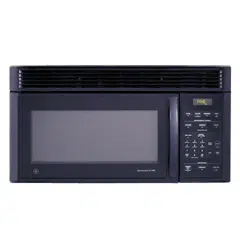Documents: Go to download!
- Owner's manual - (English)
- Operating Instructions
- Helpful Information
- Before You Call For Service
Table of contents
Owner's Manual Microwave Oven
Operating Instructions
Features of Your Microwave

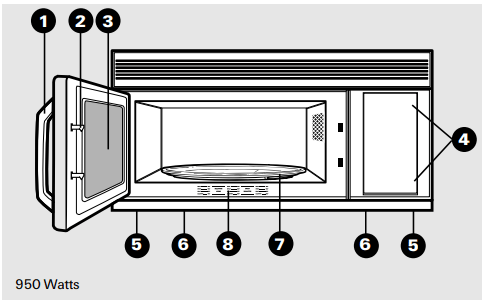
1 Door Handle. Pull to open the door. The door must be securely latched for the microwave to operate.
2 Door Latches.
3 Window with Metal Shield. Screen allows cooking to be viewed while keeping microwaves confined in the oven.
4 Touch Control Panel.
5 Cooktop Lights.
6 Grease Filters.
7 Removable Turntable. Turntable and support must be in place when using the oven. The turntable may be removed for cleaning.
8 Convenience Guide.
NOTE: Rating plate, oven vent(s) and oven light are located on the inside walls of the microwave oven.
9 Shelf (on some models). Lets you microwave several foods at once. Food microwaves best when placed directly on the turntable.
Quick Start
The Controls on Your Microwave Oven
(Throughout this manual, features and appearance may vary from your model.)
You can microwave by time, temperature, or with the convenience features.
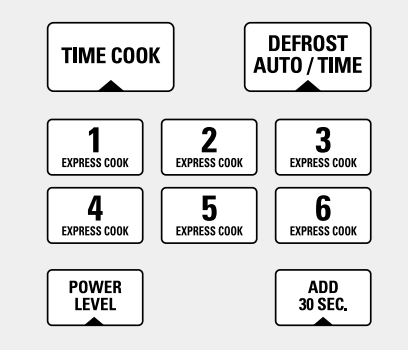
1. Time Features
Time Cooking
| Press | Enter |
| TIME COOK I & II (Press once or twice) | Amount of cooking time. |
| DEFROST AUTO/TIME (Press twice) | Amount of defrosting time. |
| EXPRESS COOK | Starts immediately! |
| POWER LEVEL | Power level 1–10. |
| ADD 30 SEC | Starts immediately! |
HELP (on some models)
Press this pad and any feature pad for usage instructions and tips
GUIDE ON MICROWAVE
Before you begin, check the guide located on the inside front of the oven when you open the door.
GUIDES IN BOOK
• Cooking
• Time Defrost
• Reheat

2. Convenience Features
| Press | Enter | Option |
| POPCORN | Starts immediately! | more/less time serving size |
| BEVERAGE | Starts immediately! | serving size |
| REHEAT | Food type 1–6 | serving size |
| DEFROST AUTO/TIME Food weight (Press once) | Food weight |
Operating Instructions
Changing Power Levels
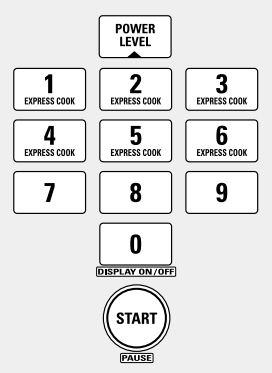
How to Change the Power Level
The power level may be entered or changed immediately after entering the feature time for TIME COOK, TIME DEFROST or EXPRESS COOK. The power level may also be changed during time countdown.
- Press TIME COOK or select Time Defrost.
- Enter cooking or defrosting time.
- Press POWER LEVEL.
- Select desired power level 1–10.
- Press START
Variable power levels add flexibility to microwave cooking. The power levels on the microwave oven can be compared to the surface units on a range. High (power level 10) or full power is the fastest way to cook and gives you 100% power. Each power level gives you microwave energy a certain percent of the time. Power level 7 is microwave energy 70% of the time. Power level 3 is energy 30% of the time.
A high setting (10) will cook faster but food may need more frequent stirring, rotating or turning over. Most cooking will be done on High (power level 10). A lower setting will cook more evenly and need less stirring or rotating of the food.
Some foods may have better flavor, texture or appearance if one of the lower settings is used. Use a lower power level when cooking foods that have a tendency to boil over, such as scalloped potatoes.
Rest periods (when the microwave energy cycles off) give time for the food to “equalize” or transfer heat to the inside of the food. An example of this is shown with power level 3—the defrost cycle. If microwave energy did not cycle off, the outside of the food would cook before the inside was defrosted. Here are some examples of uses for various power levels:
Power Level Best Uses
| High 10 | Fish, bacon, vegetables, boiling liquids. |
| Med-High 7 | Gentle cooking of meat and poultry; baking casseroles and reheating. |
| Medium 5 | Slow cooking and tenderizing such as stews and less tender cuts of meat. |
| Low 2 or 3 | Defrosting without cooking; simmering; delicate sauces. |
| Warm 1 | Keeping food warm without overcooking; softening butter. |
Time Features
Time Cook
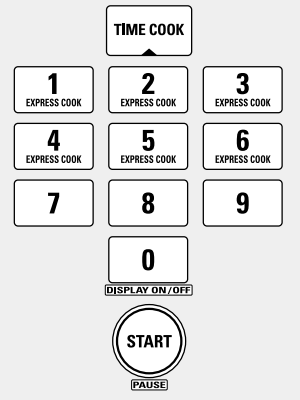
- Press TIME COOK.
- Enter cooking time.
- Change power level if you don’t want full power. (Press POWER LEVEL. Select a desired power level 1–10.)
- Press START
Time Cook I
Allows you to microwave for any time up to 99 minutes and 99 seconds.
Power level 10 (High) is automatically set, but you may change it for more flexibility.
You may open the door during Time Cook to check the food. Close the door and press START to resume cooking.
Time Cook II
Lets you change power levels automatically during cooking. Here’s how to do it:
1. Press TIME COOK.
2. Enter the first cook time.
3. Change the power level if you don’t want full power. (Press POWER LEVEL. Select a desired power level 1–10.)
4. Press TIME COOK again.
5. Enter the second cook time.
6. Change the power level if you don’t want full power. (Press POWER LEVEL. Select a power level 1–10.)
7. Press START.
At the end of Time Cook I, Time Cook II counts down.
Cooking Guide for Time Cook I & II
NOTE: Use power level High (10) unless otherwise noted.
| Vegetable | Amount | Time | Comments |
| Asparagus | |||
| (fresh spears) | 1 lb. | 6 to 9 min., Med-High (7) | In 11⁄2-qt. oblong glass baking dish, place 1/4 cup water. |
| (frozen spears) | 10-oz. package | 5 to 7 min. | In 1-qt. casserole. |
| Beans | |||
| (fresh green) | 1 lb. cut in half | 9 to 11 min. | In 11⁄2-qt. casserole, place 1/2 cup water. |
| (frozen green) | 10-oz. package | 6 to 8 min. | In 1-qt. casserole, place 2 tablespoons water. |
| (frozen lima) | 10-oz. package | 6 to 8 min. | In 1-qt. casserole, place 1/4 cup water |
| Beets | |||
| (fresh, whole) | 1 bunch | 17 to 21 min. | In 2-qt. casserole, place 1/2 cup water. |
| Broccoli | |||
| (fresh cut) | 1 bunch (11 ⁄4 to 11 ⁄2 lbs.) | 7 to 10 min. | In 2-qt. casserole, place 1/2 cup water. |
| (fresh spears) | 1 bunch (11 ⁄4 to 11 ⁄2 lbs.) | 9 to 13 min. | In 2-qt. oblong glass baking dish, place 1/4 cup water. |
| (frozen, chopped) | 10-oz. package | 5 to 7 min | In 1-qt. casserole. |
| (frozen spears) | 10-oz. package | 5 to 7 min | In 1-qt. casserole, place 3 tablespoons water. |
| Cabbage | |||
| (fresh) | 1 medium head (about 2 lbs.) | 8 to 11 min. | In 11⁄2- or 2-qt. casserole, place 1/4 cup water |
| (wedges) | 7 to 10 min. | In 2- or 3-qt. casserole, place 1/4 cup water. | |
| Carrots | |||
| (fresh, sliced) | 1 lb. | 7 to 9 min. | In 11⁄2-qt. casserole, place 1/4 cup water. |
| (frozen) | 10-oz. package | 5 to 7 min. | In 1-qt. casserole, place 2 tablespoons water. |
| Cauliflower | |||
| (flowerets) | 1 medium head | 9 to 14 min. | In 2-qt. casserole, place 1/2 cup water |
| (fresh, whole) | 1 medium head | 10 to 17 min. | In 2-qt. casserole, place 1/2 cup water. |
| (frozen) | 10-oz. package | 5 to 7 min. | In 1-qt. casserole, place 2 tablespoons water. |
| Corn | |||
| (frozen kernel) | 10-oz. package | 5 to 7 min. | In 1-qt. casserole, place 2 tablespoons water. |
| Corn on the cob | |||
| (fresh) | 1 to 5 ears | 3 to 4 min. per ear | In 2-qt. oblong glass baking dish, place corn. If corn is in husk, use no water; if corn has been husked, add 1/4 cup water. Rearrange after half of time |
| (frozen) | 1 ear 2 to 6 ears | 5 to 6 min. 3 to 4 min. per ear | Place in 2-qt. oblong glass baking dish. Cover with vented plastic wrap. Rearrange after half of the time. |
| Mixed vegetables | |||
| (frozen) | 10-oz. package | 5 to 7 min. | In 1-qt. casserole, place 3 tablespoons water. |
| Peas | |||
| (fresh, shelled) | 2 lbs. unshelled | 9 to 12 min. | In 1-qt. casserole, place 1/4 cup water. |
| (frozen) | 10-oz. package | 5 to 7 min. | In 1-qt. casserole, place 2 tablespoons water. |
| Potatoes | |||
| (fresh, cubed, white) | 4 potatoes (6 to 8 oz. each | 9 to 12 min. | Peel and cut into 1 inch cubes. Place in 2-qt. casserole with 1/2 cup water. Stir after half of time. |
| (fresh, whole, sweet or white) | 1 (6 to 8 oz.) | 3 to 4 min. | Pierce with cooking fork. Place in center of the oven. Let stand 5 minutes. |
| Spinach | |||
| (fresh) | 10 to 16 oz. | 5 to 7 min. | In 2-qt. casserole, place washed spinach. |
| (frozen, chopped and leaf) | 10-oz. package | 5 to 7 min. | In 1-qt. casserole, place 3 tablespoons water. |
| Squash | |||
| (fresh, summer and yellow) | 1 lb. sliced | 5 to 7 min | In 11⁄2-qt. casserole, place 1/4 cup water. |
| (winter, acorn butternut) | 1 to 2 squash (about 1 lb. each) | 8 to 11 min. | Cut in half and remove fibrous membranes. In 2-qt. oblong glass baking dish, place squash cut-side down. Turn cut-side-up after 4 minutes. |
Time Features
Time Defrost

1. Press DEFROST AUTO/TIME twice.
2. Enter defrosting time.
3. Press START.
4. Turn food over when the oven signals.
5. Press START. (Auto Defrost explained in the section on Convenience Features.)
Allows you to defrost for the length of time you select. See the Defrosting Guide for suggested times
Power level 3 is automatically set, but you may change this for more flexibility. You may defrost small items more quickly by raising the power level after entering the time. However, they will need more frequent attention than usual.
Power level 7 cuts the total defrosting time in about half; power level 10 cuts the total time to approximately 1/3. Rotate or stir food frequently.
At one half of selected defrosting time, the oven signals TURN. At this time, turn food over and break apart or rearrange pieces for more even defrosting. Shield any warm areas with small pieces of foil.
A dull thumping noise may be heard during defrosting. This sound is normal when the oven is not operating at High power.
Defrosting Tips
- Foods frozen in paper or plastic can be defrosted in the package. Tightly closed packages should be slit, pierced or vented AFTER food has partially defrosted. Plastic storage containers should be at least partially uncovered.
- Family-size, prepackaged frozen dinners can be defrosted and microwaved. If the food is in a foil container, transfer it to a microwave-safe dish.
- Foods that spoil easily, such as milk, eggs, fish, stuffings, poultry and pork, should not be allowed to sit out for more than one hour after defrosting. Room temperature promotes the growth of harmful bacteria.
- For more even defrosting of larger foods, such as beef, lamb and veal roasts, use Auto Defrost.
- Be sure large meats are completely defrosted before cooking.
- When defrosted, food should be cool but softened in all areas. If still slightly icy, return to the microwave very briefly, or let it stand a few minutes.
Defrosting Guide

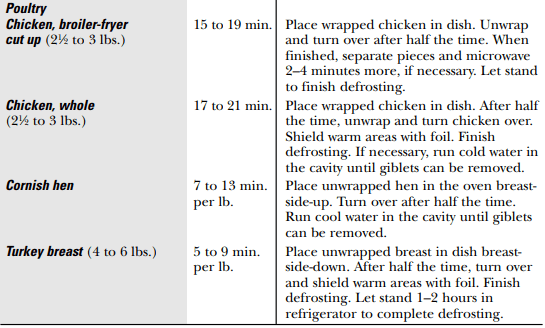
Time Features
Express Cook

This is a quick way to set cooking time for 1–6 minutes.
Press one of the Express Cook pads (from 1 to 6) for 1 to 6 minutes of cooking at power level 10. For example, press the 2 pad for 2 minutes of cooking time.
The power level can be changed as time is counting down. Press POWER LEVEL and enter 1–10.
Add 30 Seconds

You can use this feature two ways:
- It will add 30 seconds to the time counting down each time the pad is pressed.
- It can be used as a quick way to set 30 seconds of cooking time.
Convenience Features
Popcorn
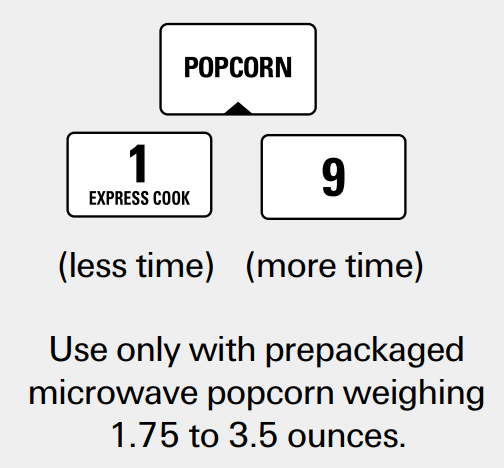
NOTE: Do not use the metal shelf when cooking popcorn
How to Use the Popcorn Feature
- Follow package instructions, using Time Cook if the package is less than 1.75 ounces or larger than 3.5 ounces. Place the package of popcorn in the center of the microwave.
- Press POPCORN. The oven starts immediately. Tap POPCORN to select the bag size you are cooking.
How to Adjust the Popcorn Program to Provide a Shorter or Longer Cook Time
If you find that the brand of popcorn you use underpops or overcooks consistently, you can add or subtract 20–30 seconds to the automatic popping time.
To add time:
After pressing POPCORN, press 9 immediately after the oven starts for an extra 20 seconds.
On some models, press 9 again to add another 10 seconds (total 30 seconds additional time).
To subtract time:
After pressing POPCORN, press 1 immediately after the oven starts for 20 seconds less cooking time.
On some models, press 1 again to reduce cooking time another 10 seconds (total 30 seconds less time).
Convenience Features
Reheat
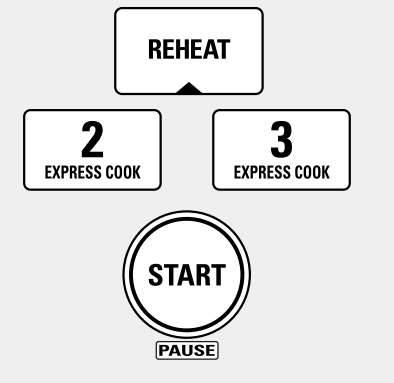
NOTE: Do not use the metal shelf when using the Reheat feature.
The Reheat feature reheats servings of many previously cooked foods.
- Press REHEAT.
- Select food type 1–6 for one serving (see Reheat Guide below). On some models, the oven starts immediately.
- Press 2 or 3 to change the serving size.
- On some models, press START.
NOTE: The serving size may be changed or added after the oven starts. Press number pad 2 or 3. On some models, the serving size for food type 6 cannot be changed.
Reheat Guide
| Food Type | Comments |
| 1 Pasta | Cover with lid or vented plastic wrap. |
| 2 Meats, casseroles, pizza | Cover with lid or vented plastic wrap. |
| 3 Fruits and vegetables | Cover with lid or vented plastic wrap. |
| 4 Beverages, 8–10 oz. | Works best with wide mouth mug—do not cover. |
| 5 Sauces and gravies | Cover with lid or vented plastic wrap. |
6 Plate of leftovers (2 to 3 foods, 4 oz. each) | Cover with lid or vented plastic wrap. |
Beverage
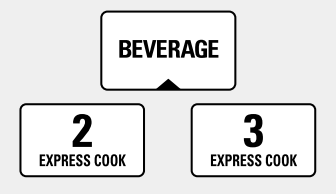

The Beverage feature heats servings of any beverage. Press BEVERAGE. The oven starts immediately.
On some models, the serving size is automatically set at 1, but can be changed by pressing 2 or 3 right after pressing BEVERAGE.
On model JVM1430 only, the serving size is automatically set at 4 ounces, but can be changed by tapping BEVERAGE to select 8 or 12 ounces.
Drinks heated with the Beverage feature may be very hot. Remove the container with care.
Auto Defrost

1. Press DEFROST AUTO/TIME once.
2. Using the Conversion Guide at right, enter food weight. For example, press pads 1 and 2 for 1.2 pounds (1 pound, 3 ounces).
3. Press START.
(Time Defrost is explained in the Time Features section.)
The Defrost Auto/Time feature gives you two ways to defrost frozen foods. Press DEFROST AUTO/TIME once for Auto Defrost or twice for Time Defrost. Use Auto Defrost for meat, poultry and fish.
Use Time Defrost for most other frozen foods.
Auto Defrost automatically sets the defrosting times and power levels to give even defrosting results for meats, poultry and fish weighing up to six pounds.
There is a handy guide located on the inside front of the oven.
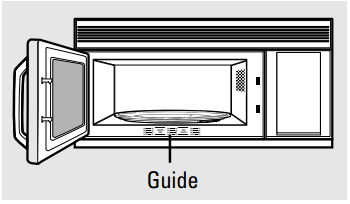
Conversion Guide
If the weight of food is stated in pounds and ounces, the ounces must be converted to tenths (.1) of a pound.
| Weight of Food in Ounces | Enter Food Weight (tenths of a pound) |
| 1-2 | .1 |
| 3 | .2 |
| 4-5 | .3 |
| 6-7 | .4 |
| 8 | .5 |
| 9-10 | .6 |
| 11 | .7 |
| 12-13 | .8 |
| 14-15 | .9 |
• Remove meat from package and place on microwave-safe dish.
• Twice during defrost, the oven signals TURN. At each TURN signal, turn the food over. Remove defrosted meat or shield warm areas with small pieces of foil.
• After defrosting, most meats need to stand 5 minutes to complete defrosting. Large roasts should stand for about 30 minutes.
Other Features Your Model May Have
Help (On some models)

The HELP pad displays feature information and helpful hints. Press HELP, then select a feature pad.
Cooking Complete Reminder
To remind you that you have food in the oven, the oven will display “FOOD IS READY” or “END” and beep once a minute until you either open the oven door or press CLEAR/OFF.
Clock
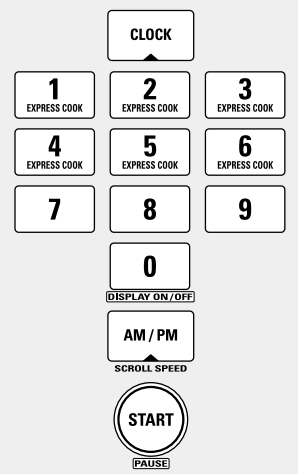
Press to enter the time of day or to check the time of day while microwaving.
1. Press CLOCK.
2. Enter time of day.
3. On some models, select AM or PM.
4. Press START or CLOCK.
Other Features Your Model May Have
Scroll Speed
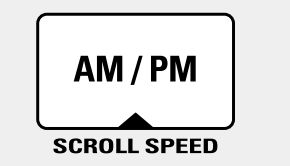
The scroll speed of the display can be changed. Press and hold the AM/PM pad about 3 seconds to bring up the display. Select 1–5 for slow to fast scroll speed.
Display On/Off

To turn the clock display off, press and hold 0 for about three seconds.
To redisplay the clock, repeat.
Delay Start
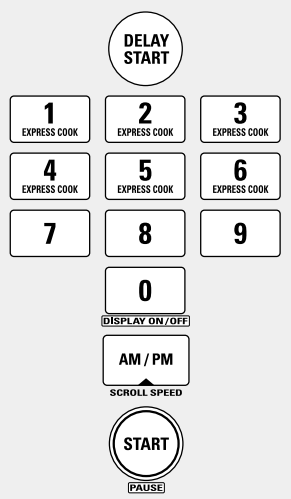
Delay Start allows you to set the microwave to delay cooking up to 24 hours.
1. Press DELAY START.
2. Enter the time you want the oven to start. (Be sure the microwave clock shows the correct time of day.)
3. On some models, select AM or PM.
4.Select any combination of Defrost Auto/Time or Time Cook I & II.
5. Press START.
The Delay Start time will be displayed. The oven will automatically start at the delayed time.
The time of day may be displayed by pressing CLOCK.
Timer On/Off
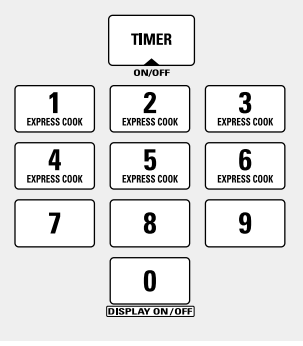
Timer On/Off operates as a minute timer and can be used at any time, even when the oven is operating.
- Press TIMER ON/OFF.
- Enter time you want to count down.
- Press TIMER ON/OFF to start.
When time is up, the oven will signal. To turn off the timer signal, press TIMER ON/OFF.
NOTE: The timer indicator will be lit while the timer is operating
Start/Pause

In addition to starting many functions, START/PAUSE allows you to stop cooking without opening the door or clearing the display
Reminder (On some models)
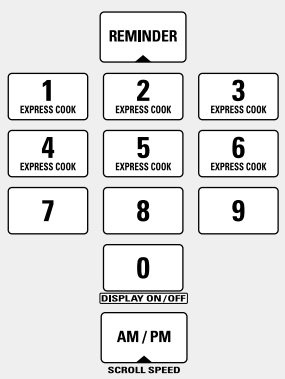
The Reminder feature can be used like an alarm clock and can be used at any time, even when the oven is operating. The Reminder time can be set up to 24 hours later.
- Press REMINDER.
- Enter the time you want the oven to remind you. (Be sure the microwave clock shows the correct time of day.)
- On some models, select AM or PM.
- Press REMINDER. When Reminder signal occurs, press REMINDER to turn it off. The Reminder time may be displayed by pressing REMINDER.
NOTE: The REM indicator will remain lit to show that the Reminder is set. To clear the Reminder before it occurs, press REMINDER, then 0. The REM indicator will no longer be lit.
Child Lock-Out

You may lock the control panel to prevent the microwave from being accidentally started or used by children.
To lock or unlock the controls, press and hold CLEAR/OFF for about 3 seconds. When the control panel is locked, “L” or “LOC” will be displayed to the extreme right.
Turntable (On some models)

For best cooking results, leave the turntable on. It can be turned off for large dishes. Press TURNTABLE to turn the turntable on or off.
Sometimes the turntable can become too hot to touch. Be careful touching the turntable during and after cooking.
Automatic Fan
An automatic fan feature protects the microwave from too much heat rising from the cooktop below it. It automatically turns on if it senses too much heat.
If you have turned the fan on you may find that you cannot turn it off. The fan will automatically turn off when the internal parts are cool. It may stay on for 30 minutes or more after the cooktop and microwave controls are turned off.
Surface Light

Press to turn the surface light on or off.
On some models, there is a night light option.
Press SURFACE LIGHT once for bright light, twice for the night light or three times to turn the light off.
Beeper Volume (On some models)

The beeper sound level can be adjusted. Press BEEPER VOLUME.
Choose 0–3 for mute to loud.
Vent Fan

The vent fan removes steam and other vapors from surface cooking.
Press VENT FAN once for high fan speed, twice for low fan speed or a third time to turn the fan off.
Shelf (on some models)
How to Use the Shelf When Microwaving
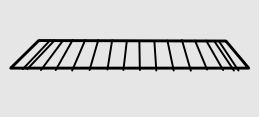
- Make sure the shelf is positioned properly inside the microwave to prevent damage to the oven from arcing.
- Do not use a microwave browning dish on the shelf. The shelf could overheat.
- Do not use the oven with the shelf on the microwave floor. This could damage the microwave.
- Use pot holders when handling the shelf— it may be hot.
- Do not use the shelf when cooking popcorn.
- Do not use the shelf with the Reheat feature.
Food microwaves best when placed on the turntable or on the shelf in the lower position. Only use the shelf when reheating on more than one level. Do not store the shelf inside the oven cavity.

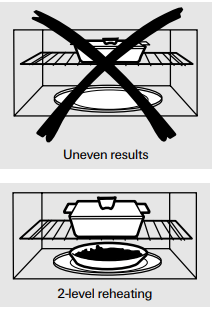
Shelf and Reheating
• To reheat on 2 levels or
• To reheat 2 dishes on the lower level:
- Multiply reheat time by 11 /2.
- Switch places after 1/2 the time.
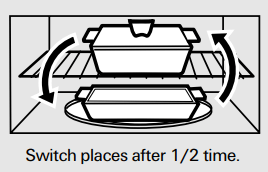

Helpful Information
Microwave Terms
| Term | Definition |
| Arcing | Arcing is the microwave term for sparks in the oven. Arcing is caused by: • the metal shelf being installed incorrectly and touching the microwave walls. • metal or foil touching the side of the oven. • foil that is not molded to food (upturned edges act like antennas). • metal such as twist ties, poultry pins, gold-rimmed dishes. • recycled paper towels containing small metal pieces. |
| Covering | Covers hold in moisture, allow for more even heating and reduce cooking time. Venting plastic wrap or covering with wax paper allows excess steam to escape. |
| Shielding | In a regular oven, you shield chicken breasts or baked foods to prevent over-browning. When microwaving, you use small strips of foil to shield thin parts, such as the tips of wings and legs on poultry, which would cook before larger parts. |
| Standing Time | When you cook with regular ovens, foods such as roasts or cakes are allowed to stand to finish cooking or to set. Standing time is especially important in microwave cooking. Note that a microwaved cake is not placed on a cooling rack. |
| Venting | After covering a dish with plastic wrap, you vent the plastic wrap by turning back one corner so excess steam can escape. |
Care and Cleaning
Helpful Hints
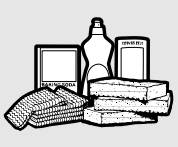
An occasional thorough wiping with a solution of baking soda and water keeps the inside fresh.
NOTE: Be certain the power is off before cleaning any part of this oven.
How to Clean the Inside
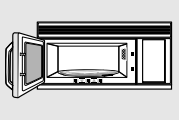
Walls, Floor, Inside Window, Metal and Plastic Parts on the Door
Some spatters can be removed with a paper towel, others may require a damp cloth. Remove greasy spatters with a sudsy cloth, then rinse with a damp cloth. Do not use abrasive cleaners or sharp utensils on oven walls. Never use a commercial oven cleaner on any part of your microwave.
Removable Turntable and Turntable Support
To prevent breakage, do not place the turntable into water just after cooking. Wash it carefully in warm, sudsy water or in the dishwasher. The turntable and support can be broken if dropped. Remember, do not operate the oven without the turntable and support in place.
Shelf (on some models)
Clean with mild soap and water or in the dishwasher.
Do not clean in a self-cleaning oven.
How to Clean the Outside
We recommend against using cleaners with ammonia or alcohol, as they can damage the appearance of the microwave oven. If you choose to use a common household cleaner, first apply the cleaner directly to a clean cloth, then wipe the soiled area.
Case
Clean the outside of the microwave with a sudsy cloth. Rinse and then dry. Wipe the window clean with a damp cloth.
Control Panel and Door
Wipe with a damp cloth. Dry thoroughly. Do not use cleaning sprays, large amounts of soap and water, abrasives or sharp objects on the panel—they can damage it. Some paper towels can also scratch the control panel.
Door Seal
It’s important to keep the area clean where the door seals against the microwave. Use only mild, non-abrasive detergents applied with a clean sponge or soft cloth. Rinse well.
Bottom

Clean off the grease and dust on the bottom often. Use a solution of warm water and detergent.
Light Bulb Replacement
Cooktop Light/ Night Light
Replace the burned-out bulb with a 40-watt incandescent bulb (WB36X10003), available from your GE supplier.
- To replace the bulb(s), first disconnect the power at the main fuse or circuit breaker panel or pull the plug.
- Remove the screw from light cover and lower the cover.
- Be sure the bulb(s) to be replaced are cool before removing. After breaking the adhesive seal, remove the bulb by gently turning.
- Replace the screw. Connect electrical power to the oven.
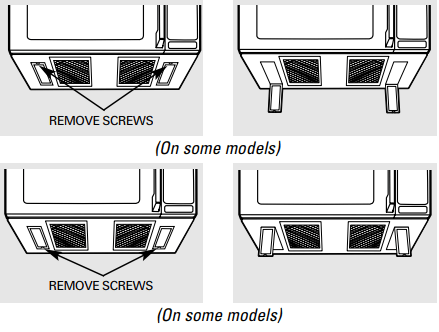
Oven Light
Replace the burned-out bulb with a 40-watt incandescent bulb (WB36X10003), available from your GE supplier.
- To replace the oven light, first disconnect the power at the main fuse or circuit breaker panel or pull the plug.
- Remove the top grille by taking out the 2 screws that hold it in place.
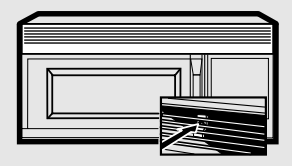
3 Next, remove the screw located above the door near the center of the oven that secures the light housing.

4 Replace the screw. Connect electrical power to the oven.
The Exhaust Feature
The Vent Fan
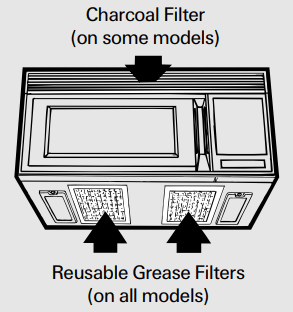
The vent fan has 2 metal reusable grease filters.
Models that recirculate air back into the room also use a charcoal filter.
Reusable Grease Filters
The metal filters trap grease released by foods on the cooktop. They also prevent flames from foods on the cooktop from damaging the inside of the microwave.
For this reason, the filters must ALWAYS be in place when the hood is used. The grease filters should be cleaned once a month, or as needed.
Removing and Cleaning the Filter
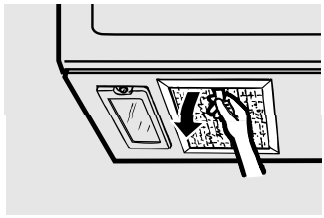
To remove, slide it to the rear using the tab. Pull it down and out.
To clean the grease filter, soak it and then swish it around in hot water and detergent. Don’t use ammonia or ammonia products because they will darken the metal. Light brushing can be used to remove embedded dirt. Rinse, shake and let it dry before replacing.
To replace, slide the filter in the frame slot on the back of the opening. Pull up and to the front to lock into place.
Charcoal Filter (on some models)
The charcoal filter cannot be cleaned. It must be replaced. Order Part No. WB2X9883 from your GE supplier.
If the model is not vented to the outside, the air will be recirculated through a disposable charcoal filter that helps remove smoke and odors.
The charcoal filter should be replaced when it is noticeably dirty or discolored (usually after 6–12 months, depending on hood usage).
To Remove Charcoal Filter
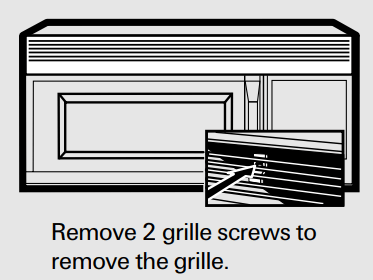
To remove the charcoal filter, disconnect power at the main fuse or circuit breaker panel or pull the plug.
Remove the top grille by removing the 2 screws that hold it in place. Slide the filter towards the front of the oven and remove it.
To Install Charcoal Filter
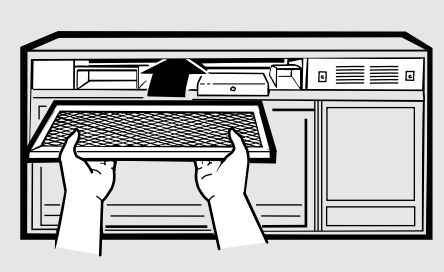
To install a new filter, remove plastic and other outer wrapping from the new filter.
Insert the filter into the top opening of the oven as shown. It will rest at an angle on 2 side support tabs and in front of the right rear tab. Replace the grille and 2 screws.
Before You Call For Service
| Problem | Possible Cause | What to Do |
| Oven will not start | A fuse in your home may be blown or the circuit breaker tripped. | • Replace fuse or reset circuit breaker. |
| Power surge. | • Unplug the microwave oven, then plug it back in. | |
| Plug not fully inserted into wall outlet | • Make sure the 3-prong plug on the oven is fully inserted into wall outlet. | |
| Floor of the oven is warm, even when the oven has not been used | The cooktop light is located below the oven floor. When the light is on, the heat it produces may make the oven floor get warm. | • This is normal. |
| “LOCKED” or “LOC” appears on display | The control has been locked. | • Press and hold CLEAR/OFF for about 3 seconds to unlock the control. |
| You hear an unusual, low-tone beep | You have tried to start the Reminder without a valid time of day. | • Start over and enter a valid time of day. |
| You have tried to change the power level when it is not allowed. | • Many of the oven’s features are preset the power level when it and cannot be changed. |
Things That Are Normal
- Steam or vapor escaping from around the door.
- Light reflection around door or outer case.
- Dimming oven light and change in the blower sound at power levels other than high.
- Dull thumping sound while oven is operating.
- TV-radio interference might be noticed while using the microwave. Similar to the interference caused by other small appliances, it does not indicate a problem with the microwave. Plug the microwave into a different electrical circuit, move the radio or TV as far away from the microwave as possible, or check the position and signal of the TV/radio antenna.
See other models: PTC22MFMARBB JGBP30BEA4AD JGSS05DEM6BB PHS930SL3SS GDWF100V55BB
